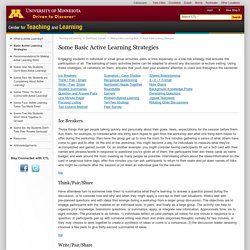

Icebreakers. 'Icebreakers' are games or activities that help "break the ice" at events where there are lots of people who don't know each other.

These games are easy to play and help the group to mix in a neutral challenge/s. this is by no means an exhaustive list and we always welcome suggestions of games you find that are good icebreakers. (email us) Ape, Man, Girl Game Both "Ape, Man, Girl" and "Elves, Wizards, Giants" are funnier team variations of the scissors, paper, stone game.
Have people pair off. Balloon Game Posted on the Christian Youthworkers egroup Tie a balloon on a string (at least two feet long) to each person's ankle. Catch the Ball, Head the Ball Suggested by Neil Savory Arrange all participants in a circle. Players that get it wrong have to sit down. Communicating Challenge Try the "Line up game" this way.... Give everyone a number. Counting Game Have everyone in your group pair up and face each other. Variation: The Math Game Crash aka: 'Clump' Variation: Elves, Wizards, Giants Human Bingo.
Some Basic Active Learning Strategies. Engaging students in individual or small group activities–pairs or trios especially–is a low-risk strategy that ensures the participation of all.

The sampling of basic activities below can be adapted to almost any discussion or lecture setting. Using these strategies, or variations on them, ensures that you'll hold your students' attention in class and throughout the semester. Ice Breakers Those things that get people talking quickly and personally about their goals, fears, expectations for the session before them. Ask them, for example, to consider what one thing each hopes to gain from the workshop and what one thing each hopes to offer during the workshop, then have the group get up to rove the room for five minutes gathering a sense of what others have come to gain and to offer. Top Think/Pair/Share Write/Pair/Share The format for this strategy is identical to the think-pair-share, except that students process the question asked of them by writing about it rather than reflecting. Top. 24 Essential Mind Mapping and Brainstorming Tools.
Mind mapping is the process of using visual diagrams to show the relationships between ideas or information.

Its popular uses include project planning, collecting and organizing thoughts, brainstorming and presentations — all in order to help solve problems, map out resources and uncover new ideas. It can be more useful than trying to keep track of our ideas by scribbling them on paper, and can aid in manipulating and generating concepts. We've compiled a list of 24 mind mapping tools to help you organize, summarize and visualize information, with both free and paid versions available to suit any budget or requirement.
The tools mentioned are either browser- or desktop-based, with a selection of mind mapping mobile apps at the end of the article for use on iOS and Android devices. Is there a particular mind mapping tool you would recommend? 1. MindMeister was built to facilitate collaboration for mind mapping and brainstorming, with an intuitive, easy-to-use interface. 2. iMindMap 3. 4. Mind Mapping for Kids - Mind Mapping Resources. 10 Mind Mapping Strategies For Teachers. 10 Mind Mapping Strategies For Teachers by Andrea Leyden, examtime.com The adoption of Mind Maps in teaching has grown recently due to the benefits of using Mind Maps to learn and the availability of free online mind mapping software.

Teachers have recognized the value of using Mind Maps to engage students, encourage creativity and, most importantly, teaching how to learn rather simply memorizing content. Mind Maps have even been integrated into emerging teaching techniques such as the Flipped Classroom and Design Thinking as outlined in the Mind Map on the right. How do teachers harness the full power of Mind Mapping? Mind Mapping Strategies for Teachers Pre-class: In-class: Teaching: Online Mind Maps can be used in class to brainstorm and generate discussions. Outside class: Collaboration: The new generation of “Digital Citizens” are highly adaptable to change and expect to use technology as part of their education.